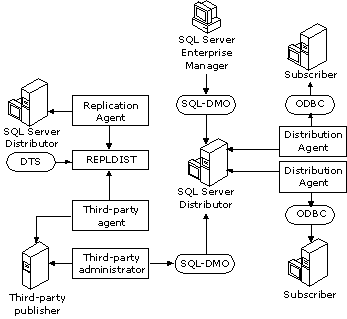
By using SQL Server 7.0 , you can easily replicate data from one database to another throughout the enterprise. The SQL Server replication technology copies data, moves these copies to different locations, and synchronizes the data so that all copies have the same data values. Other options allow you to selectively designate data from your tables to be replicated from a source database to a destination database. Replication can also be implemented between databases on the same server or on different servers connected by local area networks (LANs), wide area networks (WANs), or the Internet.
SQL Server 7.0 supports:
SQL Server includes an ODBC driver that supports Oracle subscriptions to SQL Server on Intel-based computers. Other databases that provide 32-bit ODBC drivers on Windows NT, such as Sybase and Informix, can be part of the replication design.
The Replication Distribution Interface (RDI) allows replication of data from heterogeneous data sources such as Microsoft Access or Oracle. Replication ActiveX controls provide a means of programmatically controlling Merge Agent and Distribution Agent activity at a Subscriber that has a pull subscription.

A company using Oracle is often concerned about using other databases because the information in the new database may not be accessible at the enterprise level. Using the previous example of a training company that has a central Oracle database system running Oracle financials, the environment is one in which the information technology (IT) staff is well-versed in Oracle and its development tools. When a department decided to purchase a SQL Server system, IT was concerned about how the SQL Server system would be supported and how it would integrate with the Oracle database.
In this case, all of the transactional inputs are maintained at the department level; however, some of the data in the departmental system is needed periodically for centralized reporting. Replication services are employed, allowing replication of the required data in the Oracle database, creating a planned, off-time window of network activity to move the data to the central database immediately prior to the scheduled report runs. This allows the two systems to coexist, giving the department the system they required, and still satisfying the need of central IT for data access.
SQL Server 7.0 provides a variety of replication options to choose from when considering replication between a variety of Publishers and Subscribers, including:
Transactional replication is the original SQL Server Publisher/Subscriber model. It uses the transaction log to monitor changes to data. Changes are queued and then sent and applied to Subscribers.
Snapshot replication takes a picture, or snapshot, of the published data in the database at one moment in time. Snapshot replication requires less constant processor overhead than transactional replication because it does not require continuous monitoring of data changes on source servers.
Merge is a new replication model in which users work freely and independently. At a later time, the work is combined into a single, uniform result. This model is ideal for offline or disconnected applications.
In addition, the overall replication architecture in SQL Server 7.0 has been enhanced and includes:
For more information about the replication capabilities in SQL Server 7.0, see "Replication" earlier in this volume.